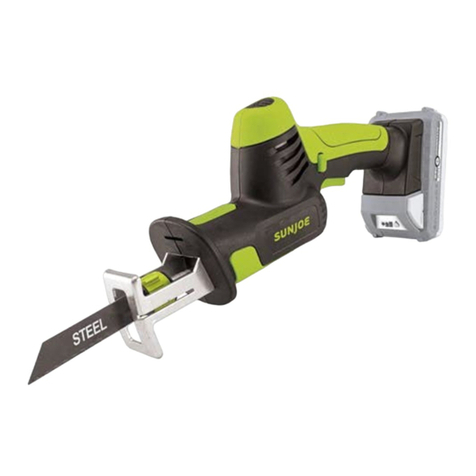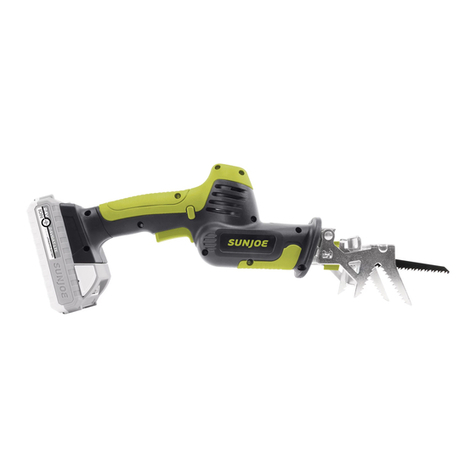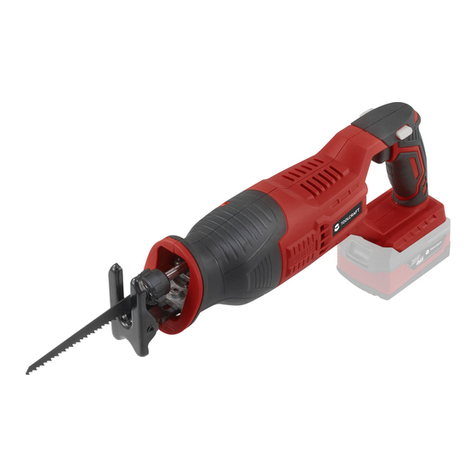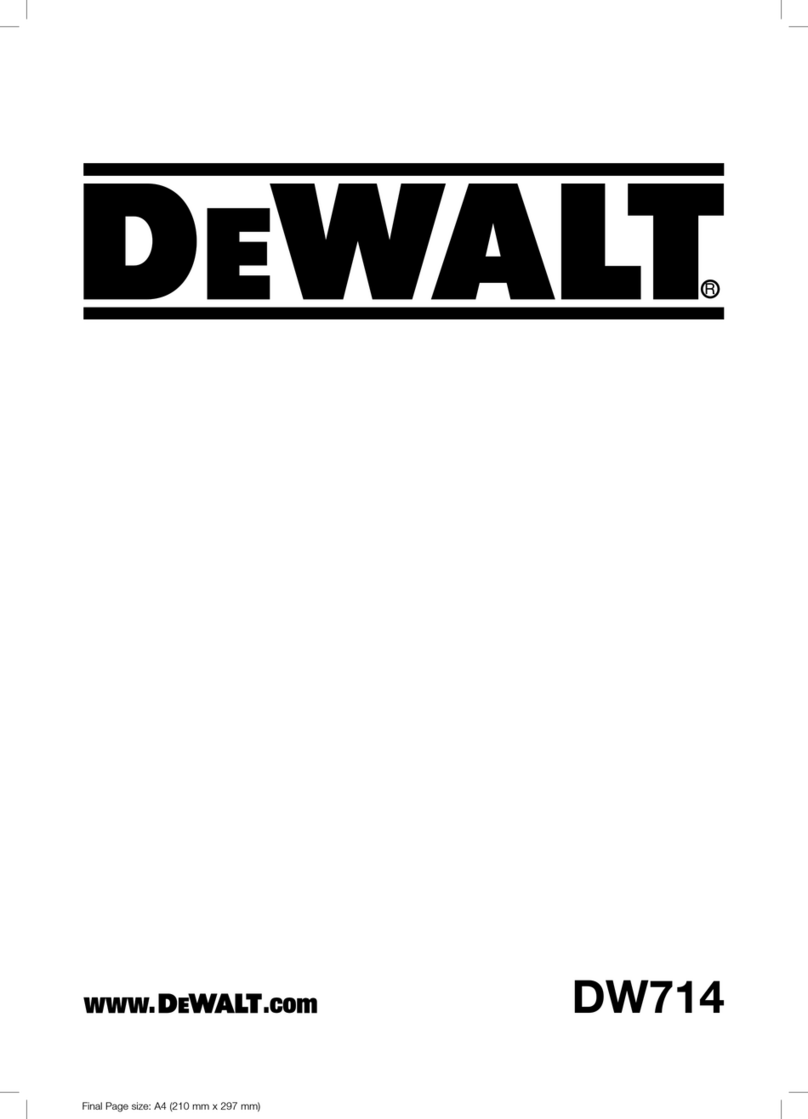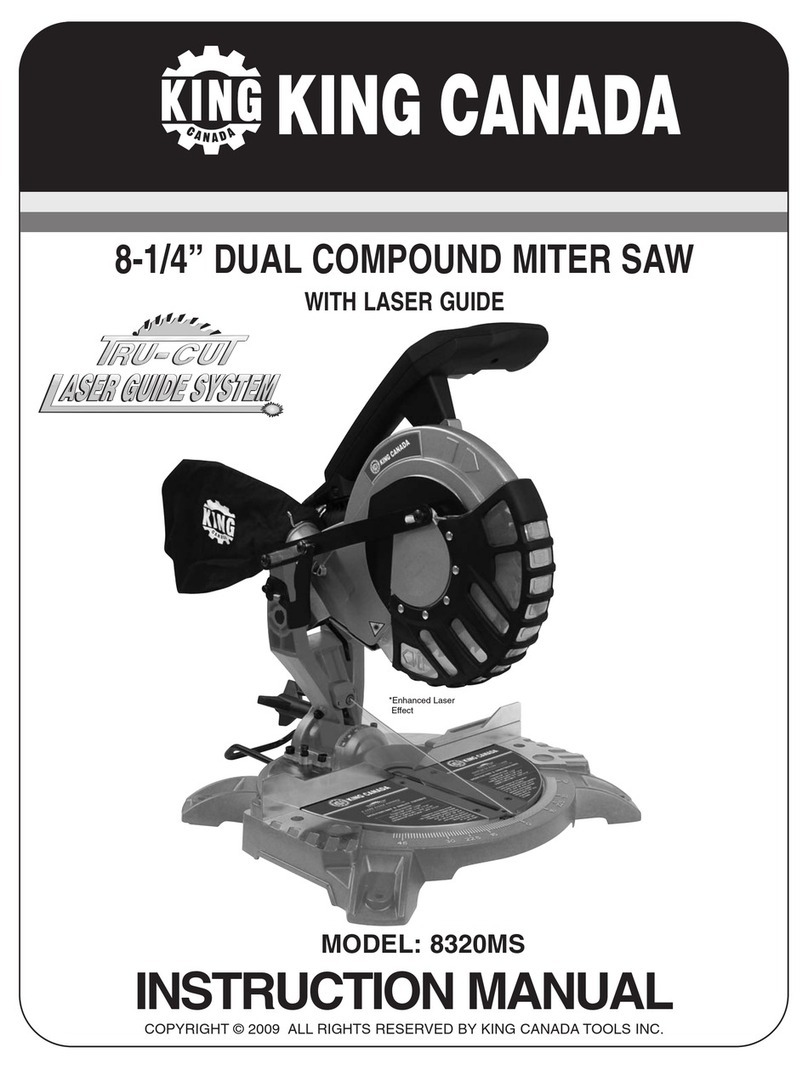SNOWJOE sunjoe 24V-HCS-LTE-RM User manual

© 2022 by Snow Joe, LLC
All rights reserved. Original instructions. SAVE THESE INSTRUCTIONS
A Division of Snow Joe, LLC
OPERATOR’S MANUAL
R
Model 24V-HCS-LTE-RM Form No. SJ-24V-HCS-LTE-RM-880E-M-V1
CORDLESS PRUNING SAW
24V MAX* | 2.0 Ah | 5-INCH

© 2022 by Snow Joe, LLC
All rights reserved. Original instructions. SAVE THESE INSTRUCTIONS
1
A Division of Snow Joe, LLC
OPERATOR’S MANUAL
R
Model 24V-HCS-LTE-RM Form No. SJ-24V-HCS-LTE-RM-880E-M-V1
CORDLESS PRUNING SAW
24V MAX* | 2.0 Ah | 5-INCH
IMPORTANT!
Safety Instructions
All Operators Must Read These
Instructions Before Use
Read all safety warnings and all instructions. Failure to follow
the warnings and instructions may result in electric shock, re
and/or serious injury. Save all warnings and instructions for
future reference.
mDANGER! This indicates a hazardous situation, which,
if not followed, will result in serious injury or death.
mWARNING! This indicates a hazardous situation, which,
if not avoided, could result in serious injury or death.
mCAUTION! This indicates a hazardous situation, which,
if not avoided, could result in minor or moderate injury.
Intended Use
This cordless prunning saw was designed and manufactured
for trimming and pruning tree limbs and branches and for
cutting smaller logs up to recommended 4.5 inch
(11.4 cm), not to exceed a max. cut of 5.5 in. (14 cm) in
diameter depending on type of wood. All of the wooden
objects intended to be cut with this pruning saw should be no
thicker than the guide bar's maximum cutting capabilities.
Any other use diering from the above mentioned applications
poses a serious hazard to the user and may damage both the
tool and your personal property. Improper use of the machine
will invalidate the warranty, relieve the manufacturer from all
liabilities. The user will consequently be liable for all and any
damage or injury to himself/herself or others.
General Power Tool Safety
Warnings
mWARNING! Read all safety warnings, instructions,
illustrations and specications provided with this power tool.
Failure to follow all instructions listed below may result in
electric shock, re and/or serious injury. Save all warnings and
instructions for future reference.
Work Area Safety
1. Keep work area clean and well lit – Cluttered or dark
areas invite accidents.
2. Do not operate power tools in explosive atmospheres,
such as in the presence of ammable liquids, gases
or dust – Power tools create sparks which may ignite the
dust or fumes.
3. Keep children and bystanders away while operating a
power tool – Distractions can cause you to lose control.
Electric Safety
1. Power tool plugs must match the outlet. Never modify
the plug in any way. Do not use any adapter plugs with
earthed (grounded) power tools – Unmodied plugs and
matching outlets will reduce risk of electric shock.
2. Avoid body contact with earthed or grounded
surfaces, such as pipes, radiators, ranges and
refrigerators – There is an increased risk of electric shock
if your body is earthed or grounded.
3. Do not abuse the cord. Never use the cord for
carrying, pulling or unplugging the power tool. Keep
cord away from heat, oil, sharp edges or moving parts
–Damaged or entangled cords increase the risk of electric
shock
4. When operating a power tool outdoors, use an
extension cord suitable for outdoor use – Use of a cord
suitable for outdoor use reduces the risk of electric shock.
5. If operating a power tool in a damp location is
unavoidable, use a RESIDUAL CURRENT DEVICE
(RCD) protected supply – Use of an RCD reduces the
risk of electric shock
Personal Safety
1. Stay alert, watch what you are doing and use common
sense when operating a power tool. Do not use a
power tool while you are tired or under the inuence
of drugs, alcohol or medication – A moment of
inattention while operating power tools may result in
serious personal injury.
2. Use personal protective equipment. Always wear
eye protection – Protective equipment such as dust
mask, non-skid safety shoes, hard hat, or hearing
protection used for appropriate conditions will
reduce personal injuries.
3. Prevent unintentional starting. Ensure the switch is
in the o-position before connecting battery pack,

2
picking up or carrying the tool – Carrying power tools
with your nger on the switch or energising power tools
that have the switch on invites accidents.
4. Remove any adjusting key or wrench before
turning the power tool on – A wrench or a key left
attached to a rotating part of the power tool may result
in personal injury.
5. Do not overreach. Keep proper footing and balance at
all times – This enables better control of the power tool in
unexpected situations.
6. Dress properly. Do not wear loose clothing or jewelry.
Keep your hair, clothing and gloves away from moving
parts – Loose clothes, jewellery or long hair can be
caught in moving parts.
7. If devices are provided for the connection of dust
extraction and collection facilities, ensure these are
connected and properly used – Use of dust collection
can reduce dust-related hazards.
8. Do not let familiarity gained from frequent use of tools
allow you to become complacent and ignore tool
safety principles. A careless action can cause severe
injury within a fraction of a second.
Power Tool Use and Care
1. Do not force the power tool. Use the correct power
tool for your application – The correct power tool will
do the job better and safer at the rate for which it was
designed.
2. Do not use the power tool if the switch does not turn
it on and o – Any power tool that cannot be controlled
with the switch is dangerous and must be repaired.
3. Disconnect the battery pack from the power
tool before making any adjustments, changing
accessories, or storing power tools – Such
preventive safety measures reduce the risk of starting
the power tool accidentally.
4. Store idle power tools out of the reach of children and
do not allow persons unfamiliar with the power tool or
these instructions to operate the power tool – Power
tools are dangerous in the hands of untrained users.
5. Maintain power tools. Check for misalignment or
binding of moving parts, breakage of parts and any
other condition that may aect the power tool’s
operation. If damaged, have the power tool repaired
before use – Many accidents are caused by poorly
maintained power tools.
6. Keep cutting tools sharp and clean – Properly
maintained cutting tools with sharp cutting edges are less
likely to bind and are easier to control.
7. Use the power tool, accessories etc. in accordance
with these instructions, taking into account the
working conditions and the work to be performed –
Use of the power tool for operations dierent from those
intended could result in a hazardous situation.
8. Keep handles and grasping surfaces dry, clean and
free from oil and grease. Slippery handles and grasping
surfaces do not allow for safe handling and control of the
tool in unexpected situations.
Battery Tool Use and Care
mWARNING! Read all safety warnings and instructions.
Failure to follow the warnings and instructions may result in
electric shock, re and/or serious injury.
1. Recharge only with the charger specied by the
manufacturer. A charger that is suitable for one type of
battery pack may create a risk of re when used with
another battery pack.
2. Use appliances only with specically designated battery
packs. Use of any other battery packs may create a risk of
injury and re.
3. When the battery pack is not in use, keep it away from
other metal objects, like paper clips, coins, keys, nails,
screws or other small metal objects, that can make a
connection from one terminal to another. Shorting the
battery terminals together may cause burns or a re.
4. Under abusive conditions, liquid may be ejected from
the battery; avoid contact. If contact accidentally occurs,
ush with water. If liquid contacts eyes, additionally seek
medical help. Liquid ejected from the battery may cause
irritation or burns.
5. Do not use a battery pack or appliance that is damaged
or modied. Damaged or modied batteries may exhibit
unpredictable behavior resulting in re, explosion or risk of
injury.
6. Do not expose a battery pack or appliance to re or
excessive temperature. Exposure to re or temperature
above 104°F(40.5°C) may cause explosion.
7. Follow all charging instructions and do not charge the
battery pack or appliance outside of the temperature
range specied in the instructions. Charging improperly
or at temperatures outside of the specied range may
damage the battery and increase the risk of re.
8. Do not modify or attempt to repair the appliance or the
battery pack (as applicable) except as indicated in the
instructions for use and care.
Service
1. Have your power tool serviced by a qualied repair
person using only identical replacement parts. This will
ensure that the safety of the power tool is maintained.
2. Never service damaged battery packs. Service
of battery packs should only be performed by the
manufacturer or authorized service providers.

3
Safety Instructions for
Pruning Saws
General Pruning Saw Safety Warnings
• Keep all parts of the body away from the saw chain
when the pruning saw is operating. Before you start
the pruning saw, make sure the saw chain is not
contacting anything. A moment of inattention while
operating the pruning saw may cause entanglement of
your clothing or body with the saw chain.
• Hold the power tool by insulated gripping surfaces
only, because the saw chain may contact hidden
wiring. Saw chains contacting a "live" wire may make
exposed metal part of the power tool "live" and give the
operator a electric shock.
• Wear safety glasses and hearing protection. Further
protective equipment for head, hands, legs and feet is
recommended. Adequate protective clothing will reduce
personal injury by ying debris or accidental contact with
the saw chain.
• Always keep proper footing and operate the pruning
saw only when standing on a xed, secured and level
surface. Slippery or unstable surfaces such as ladders
may cause a loss of balance or control of the saw.
• When cutting a limb that is under tension, be cautious
of spring back. When the tension in the wood bers is
released, the spring-loaded limb may strike the operator
and/or throw the pruning saw out of control.
• Use extreme caution when cutting brush and saplings.
The slender material may catch the saw chain and be
whipped toward you or pull you o balance.
• Carry the saw by the handle with the saw switched
o and away from your body. When transporting or
storing the saw, always t the guide bar cover. Proper
handling of the saw will reduce the likelihood of accidental
contact with the moving saw chain.
• Follow instructions for lubricating, chain tensioning
and changing accessories. An improperly tensioned or
poorly lubricated chain may either break or increase the
chance for kickback.
• Cut wood only. Do not use the pruning saw for any
other purpose. For example, do not use the pruning
saw to cut plastic, masonry or non-wood building
materials. Using the pruning saw in these incorrect ways
could result in serious damage to you and your tool.
• Keep guards in place. Protective guards should be
checked periodically to ensure they are properly tted and
in correct working order.
• Do not grasp the exposed cutting blade or cutting edges
when picking up or holding the saw. Be sure to encase the
cutting bar in its protective sheath when not in use.
• This saw is not intended for tree felling. Use of the
saw for operations dierent than intended could result in
serious injury to the operator or bystanders.
Causes and operator prevention of
kickback
Kickback may occur when the nose or tip of the guide bar
touches an object, or when the wood closes in and pinches
the saw chain in the cut.
Tip contact in some cases may cause a sudden reverse
reaction, kicking the guide bar up and back towards the
operator.
Pinching the saw chain along the top of the guide bar may
push the guide bar rapidly back towards the operator.
Either of these reactions may cause you to lose control of the
saw which could result in serious personal injury. Do not rely
exclusively upon the safety devices built into your saw. As a
pruning saw user, you should take several steps to keep your
cutting jobs free from accident or injury.
Kickback is the result of tool misuse and/or incorrect operating
procedures or conditions and can be avoided by taking proper
precautions as given below:
• Maintain a rm grip, with thumb and ngers encircling
the saw handle and position your body and arm to
allow you to resist kick-back forces. Kick-back forces
can be controlled by the operator, if proper precautions
are taken. Do not let go of the saw.
• Do not overreach and do not cut above shoulder
height. This helps prevent unintended tip contact and
enables better control of the unit in unexpected situations.
• Only use replacement bars and chains specied by the
manufacturer. Incorrect replacement of bars and chains
may cause chain breakage and/or kickback.
• Never use a dull or loose chain. Keep the chain sharp and
properly tensioned.
• Follow the manufacturer’s sharpening and
maintenance instructions for the saw chain. Decreasing
the depth gauge height can lead to increased kickback.
Additional safety instructions
for Pruning Saw
• The pruning saw is designed for cutting branches. Only
use the pruning saw as indicated in this manual for
cutting wood. The machine has not been designed for
continuous, professional use.
• Keep the pruning saw out of reach of children. It is not a
toy.
• Persons with limited physical, sensorial or mental abilities
are not allowed to use the pruning saw, unless they
are supervised for their safety by a qualied person or
are briefed by the responsible person how to use the
machine.
• Children and adolescents are not allowed to use the
pruning saw. Excluded from this prohibition are young
people over 16 years of age under the supervision of an
expert for the purpose of training.

4
• Please note the warning symbols. They mark all those
instructions which are important for safety reasons.
Observe these instructions as failure to do so could result
in serious injury!
• The pruning saw must be used only by one person at a
time. Make sure bystanders do not stay in the vicinity of
the pruning saw’s work area.
• Check the safe operating condition of the pruning saw, in
particular the guide bar and the saw chain, before each
operation.
• Always have a safe stand when working with the saw.
• Hold the machine rmly and securely when switching on.
• Make sure the guide bar and the saw chain must be free
when switched on and must not come into contact with
the workpiece to be cut.
• Keep your hands away from the sawing area. Do not reach
under the workpiece. Contact with the saw chain may
result in injury.
• Guide the pruning saw onto the workpiece only when
switched on. Otherwise there is a risk of kick-back if the
saw chain gets caught in the workpiece.
• When sawing, the base plate must always face against the
workpiece. The saw chain can become jammed and lead
to loss of control over the machine.
• When the cut is completed, switch o the machine and
then pull the saw chain out of the cut only after it has
come to a standstill. This way you can avoid kick-back.
• Clamp the material to be processed well. Do not support
the workpiece with your hand or foot. Do not touch
objects or the oor with the saw running. Danger of kick-
back.
• When sawing converted timber and thin branches always
use a strong support, such as a sawing trestle. Do not
stack timber pieces.
• Before cutting logs, secure the logs in position.
• When working on sloping ground, make sure to work
facing upwards.
• Be particularly careful when cutting splintered wood.
Splinters of wood can be torn along by the saw chain and
increase the risk of injury!
• Foreign objects such as nails, screws, metal parts, sand,
etc. lead to increased wear on the guide bar and saw
chain.
• A blunt saw chain can cause overheating and damage to
the motor.
• Always remove the battery when checking the chain
tension, to re-tighten it, to mount the saw chain and to
eliminate faults! Also remove the battery if you do not use
the machine temporarily.
Battery & Charger
Safety Instructions
We pay a great deal of attention to the design of every battery
pack to ensure that we supply you with batteries that are safe,
durable and have a high energy density. The battery cells have
a wide range of safety devices. Each individual cell is initially
formatted and its electrical characteristic curves are recorded.
This data is then used exclusively to be able to assemble the
best possible battery packs.
Despite all the safety precautions, caution must always be
exercised when handling batteries. The following points must
be obeyed at all times to ensure safe use. Safe use can only
be guaranteed if undamaged cells are used. Incorrect handling
of the battery pack can cause cell damage.
IMPORTANT! Analyses conrm that incorrect use and poor
care of high-performance batteries are the main factors
responsible for personal and/or product damage.
mWARNING! Use only approved replacement batteries;
other batteries may damage the cordless pruning saw and
cause it to malfunction, which can lead to serious personal
injury.
mWARNING! Do not use a battery pack or appliance that
is damaged or modied. Damaged or modied batteries may
exhibit unpredictable behavior resulting in re, explosion or
risk of injury.
Do not modify or attempt to repair the appliance or the battery
pack except as indicated in the instructions for use and care.
Have your battery pack serviced by a qualied repair person
using only identical replacement parts. This will ensure that the
safety of the battery pack is maintained.
mCAUTION! To reduce the risk of injury, charge the 24V
iON+ lithium-ion battery pack only in its designated 24V iON+
lithium-ion charger. Other types of chargers present risk of re,
personal injury and damage. Do not wire a battery pack to a
power supply plug or car cigarette lighter. Such misuse will
permanently disable or damage the battery pack.
• Avoid dangerous environments – Do not charge the
battery pack in rain, snow or in damp or wet locations.
Do not use the battery pack or charger in the presence of
explosive atmospheres (gaseous fumes, dust or ammable
materials) because sparks may be generated when inserting
or removing the battery pack, which could lead to a re.
• Charge in a well-ventilated area – Do not block the
charger vents. Keep them clear to allow for proper
ventilation. Do not allow smoking or open ames near a
charging battery pack. Vented gases may explode.
NOTE: The safe temperature range for the battery is 41°F –
105ºF (5°C – 40.5°C). Do not charge the battery outside in
freezing weather; charge it at room temperature.

5
• Maintain charger cord – When unplugging the charger, pull
the plug, not the cord, from the receptacle to reduce the
risk of damage to the electrical plug and cord. Never carry
the charger by its cord or yank it by the cord to disconnect
it from the receptacle. Keep the cord away from heat, oil
and sharp edges. Make sure the cord will not be stepped
on, tripped over or subjected to damage or stress when the
charger is in use. Do not use the charger with a damaged
cord or plug. Replace a damaged charger immediately.
• Do not use an extension cord unless it is absolutely
necessary – Using the wrong, damaged or improperly
wired extension cord poses a risk of re and electric shock.
If an extension cord must be used, plug the charger into a
properly wired 16 gauge or larger extension cord with the
female plug matching the male plug on the charger. Make
sure that the extension cord is in good electrical condition.
• Charger XZ2600-0450 is rated for 100 – 240 volt AC
only – The charger must be plugged into an appropriate
receptacle.
• Use only recommended attachments – Use of an
attachment not recommended or sold by the battery
charger or battery pack manufacturer may result in risk of
re, electric shock or personal injury.
• Unplug charger when not in use – Make sure to
disconnect battery pack from unplugged charger.
mWARNING! To reduce the risk of electric shock,
always unplug the charger before performing any cleaning or
maintenance. Do not allow water to ow into the charger.
Use a Ground Fault Circuit Interrupter (GFCI) to reduce
shock hazards.
• Do not burn or incinerate the battery pack – The battery
pack may explode, causing personal injury or damage.
Toxic fumes and materials are created when battery pack is
burned.
• Do not crush, drop or damage battery pack – Do not use
the battery pack or charger if they have sustained a sharp
blow, been dropped, run over or have been damaged in any
way (i.e. pierced with a nail, hit with a hammer, stepped on,
etc.).
• Do not disassemble – Incorrect reassembly may pose
a serious risk of electric shock, re or exposure to toxic
battery chemicals. If the battery or charger are damaged,
contact an authorized Snow Joe® + Sun Joe®dealer or
call the Snow Joe® + Sun Joe®customer service center at
1-866-SNOWJOE (1-866-766-9563) for assistance.
• Battery chemicals cause serious burns – Never let a
damaged battery pack contact the skin, eyes or mouth.
If a damaged battery pack leaks battery chemicals, use
rubber or neoprene gloves to safely dispose of it. If skin
is exposed to battery uids, wash the aected area with
soap and water and rinse with vinegar. If eyes are exposed
to battery chemicals, immediately ush with water for 20
minutes and seek medical attention. Remove and dispose
of contaminated clothing.
• Do not short circuit – A battery pack will short circuit if
a metal object makes a connection between the positive
and negative contacts on the battery pack. Do not place a
battery pack near anything that may cause a short circuit,
such as paper clips, coins, keys, screws, nails and other
metallic objects. A short-circuited battery pack poses a risk
of re and severe personal injury.
• Store your battery pack and charger in a cool, dry
place – Do not store the battery pack or charger where
temperatures may exceed 105ºF (40.5ºC), such as in
direct sunlight or inside a vehicle or metal building during
the summer.
Information about the battery
1. The battery pack supplied with your cordless pruning
saw is only partially charged. The battery pack has to be
charged completely before you use the tool for the rst
time.
2. For optimum battery performance, avoid low discharge
cycles by charging the battery pack frequently.
3. Store the battery pack in a cool place, ideally at 77°F
(25°C) and charged to at least 40%.
4. Lithium-ion batteries are subject to a natural aging
process. The battery pack must be replaced at the latest
when its capacity falls to just 80% of its capacity when
new. Weakened cells in an aged battery pack are no
longer capable of meeting the high power requirements
needed for the proper operation of your pruning saw, and
therefore pose a safety risk.
5. Do not throw battery pack into an open re as this poses
a risk of explosion.
6. Do not ignite the battery pack or expose it to re.
7. Do not exhaustively discharge the battery. Exhaustive
discharge will damage the battery cells. The most
common cause of exhaustive discharge is lengthy storage
or non-use of partially discharged batteries. Stop working
as soon as the performance of the battery falls noticeably
or the electronic protection system triggers. Place the
battery pack in storage only after they have been fully
charged.
8. Protect the battery and the tool from overloads. Overloads
will quickly result in overheating and cell damage inside
the battery housing even if this overheating is not
apparent externally.
9. Avoid damage and shocks. Immediately replace batteries
that have been dropped from a height of more than one
meter or those that have been exposed to violent shocks,
even if the housing of the battery pack appears to be
undamaged. The battery cells inside the battery may have
suered serious damage. In such instances, please read
the waste disposal information for proper battery disposal.
10. If the battery pack suers overloading and overheating,
the integrated protective cuto will switch o the
equipment for safety reasons.
IMPORTANT! Do not press the ON/OFF switch any more
if the protective cut-o has been activated. This may
damage to the battery packs.
11. Use only original battery packs. The use of other batteries
poses a re risk and may result in injuries or an explosion.

6
Information about the charger and the
charging process
1. Please check the data marked on the rating plate of the
battery charger. Be sure to connect the battery charger
to a power supply with the voltage marked on the rating
plate. Never connect it to a dierent mains voltage.
2. Protect the battery charger and its cord from damage.
Keep the charger and its cord away from heat, oil and
sharp edges. Have damaged cords repaired without delay
by a qualied technician at an authorized Snow Joe® +
Sun Joe®dealer or call the Snow Joe® + Sun Joe®
customer service center at 1-866-SNOWJOE
(1-866-766-9563).
3. Electrical plugs must match the outlet. Never modify
the plug in any way. Do not use any adapter plugs with
grounded appliances. Unmodied plugs and matching
outlets will reduce the risk of electric shock.
4. Keep the battery charger, battery pack and the cordless
tool out of the reach of children.
5. Do not use the supplied battery charger to charge other
cordless tools.
6. During periods of heavy use, the battery pack will become
warm. Allow the battery pack to cool to room temperature
before connecting it to the charger to recharge.
7. Do not overcharge the battery. Do not exceed the
maximum charging times. These charging times only apply
to discharged battery. Frequent insertion of a charged or
partially charged battery pack will result in overcharging
and cell damage. Do not leave the battery in the charger
for days on end.
8. Never use or charge the battery if you suspect that it
has been more than 12 months since the last time it was
charged. There is a high probability that the battery
pack has already suered dangerous damage
(exhaustive discharge).
9. Charging the battery at a temperature below 41°F (5°C)
will cause chemical damage to the cells and may cause a
re.
10. Do not use battery that have been exposed to heat during
the charging process, as the battery cells may have
suered dangerous damage.
11. Do not use batteries that have suered curvature or
deformation during the charging process or those that
exhibit other atypical symptoms (gassing, hissing,
cracking, etc.).
12. Never fully discharge the battery pack (maximum
recommended depth of discharge is 80%). A complete
discharge of the battery pack will lead to premature aging
of the battery cells.
Protection from environmental inuences
1. Wear suitable work clothes. Wear safety goggles.
2. Protect your cordless tool and the battery charger from
moisture and rain. Moisture and rain can cause dangerous
cell damage.
3. Do not use the cordless tool or the battery charger near
vapors and ammable liquids.
4. Use the battery charger and cordless tools only in dry
conditions and at an ambient temperature of 41ºF – 105°F
(5°C – 40.5°C).
5. Do not keep the battery charger in places where the
temperature is liable to reach over 105°F (40.5°C). In
particular, do not leave the battery charger in a car that is
parked in the sunshine.
6. Protect the battery from overheating. Overloads,
overcharging and exposure to direct sunlight will result
in overheating and cell damage. Never charge or work
with battery that have been overheated – replace it
immediately, if possible.
7. Store the charger and your cordless tool only in dry
locations with an ambient temperature of 41ºF – 105°F
(5°C – 40.5°C). Store your lithium-ion battery pack in a
cool, dry place at a temperature of 77°F (25°C). Protect
the battery pack, charger and cordless tool from humidity
and direct sunlight. Only place fully charged battery in
storage (charged to at least 40%).
8. Prevent the lithium-ion battery pack from freezing. Battery
pack that was stored below 32°F (0°C) for more than 60
minutes must be discarded.
9. When handling batteries, be wary of electrostatic charge.
Electrostatic discharges can damage the electronic
protection system and the battery cells. Avoid electrostatic
charging and never touch the battery poles.

7
Safety Symbols
The following table depicts and describes safety symbols that may appear on this product. Read, understand, and follow all
instructions on the machine before attempting to assemble and operate.
READ THE OPERATOR'S
MANUAL(S) – Read, understand
and follow all instructions in the
user manual(s) before attempting
to assemble and operate.
SAFETY ALERT – Indicates a
precaution, a warning or a danger.
The moving part will continuously
run for several seconds after you
turn o the machine.
WARNING! Do not expose the unit
to rain or wet conditions.
CAUTION! Avoid contacting the
guide bar tip with any object. Tip
contact may cause the guide bar
to move suddenly upward and
backwards, which may cause
serious injury to the user.
WEAR EYE AND HEARING
PROTECTION – For protection
against injury, wear ear defenders,
safety goggles, and head protection.
Correct direction of cutting teeth.
Symbols Symbols
Descriptions Descriptions
Indoor use only. Only use battery
charger indoors.
m
Wear safety footwear at all times to
provide protection against objects
that may accidentally fall on feet.
Wear safety gloves during use to
protect hands.

8
Know Your Cordless Pruning Saw
Read the owner’s manual and safety instructions carefully before operating cordless pruning saw. Compare the illustration below
to the cordless pruning saw in order to familiarize yourself with the location of the various controls and adjustments. Save this
manual for future reference.
1. Chain/sprocket end cover
2. End cover knob
3. Riving knife
4. 5-inch (12.7 cm) guide bar
5. 5-inch (12.7 cm) cutting chain
6. Cutting bar sheath
7. Base plate
8. 24V iON+ lithium-ion battery
(24VBAT-LTE) featuring exclusive
EcoSharp®technology
32 1
4
5
67
8 9 1110 12 13 14 15 16 17
18
19
20
21
22
9. Charge socket
10. Push lock button (2)
11. Push button for battery
indicator
12. Battery indicator
13. 24V iON+ lithium-ion charger
(XZ2600-0450)
14. Charger plug
15. Lubricating oil
16. Hex key wrench
17. Hex key wrench slot
18. Battery compartment
19. Handle grip
20. On/O switch
21. Safety lock button
22. Ventilation slots

9
Technical Data
Motor ............................................................................. 230 W
Battery Voltage Max* .................................................. 24V D.C
Battery Capacity ............................................................ 2.0 Ah
Charger Input .................................................. 100 – 240V AC,
50 – 60 Hz, 0.4A
Charger Output ...................................... 26V DC 450 mA
Charge Time Max .............................................................. 5 hr
Bar/Chain Length .......................................... 5 inch (12.7 cm)
Cutting Thickness Max ......................... Max: 4.5 in. (11.4 cm)
Oil Bottle Capacity ......................................... 0.7 Fl oz (20 ml)
Net Weight ........................................................... 4 lbs (1.8 kg)
*Initial no-load voltage, when fully charged, peaks at 24 volts; nominal voltage
under typical load is 21.6 volts.
Unpacking
Carton Contents
• Cordless pruning saw with chain and bar
pre-assembled
• Cutting bar sheath (assembled on the chain and bar)
• Hex key wrench (in the storage slot)
• 0.7 Fl oz (20 ml) lubrication oil
• 24V iON+ lithium-ion battery
• 24V iON+ lithium-ion battery charger
• Manual with registration card
1. Carefully remove the cordless pruning saw and check to
see that all of the above items are supplied.
2. Inspect the product carefully to make sure no breakage or
damage occurred during shipping. If you nd damaged or
missing parts, DO NOT return the unit to the store. Please
call the Snow Joe® + Sun Joe®customer service center at
1-866-SNOWJOE (1-866-766-9563).
NOTE: Do not discard the shipping carton and packaging
material until you are ready to use your new cordless
pruning saw. The packaging is made of recyclable
materials. Properly dispose of these materials in
accordance with local regulations.
IMPORTANT! The equipment and packaging material are
not toys. Do not let children play with plastic bags, foils,
or small parts. These items can be swallowed and pose a
suocation risk!
Battery Pack Operation
The equipment is powered by a lithium-ion battery. The battery
pack is completely sealed and maintenance free.
Battery Charge Level Indicator
The battery pack is equipped with a push button for checking
the charge level. Simply press the push button to read o the
battery charge level from the LEDs of the battery indicator:
• All 3 level monitoring LEDs are lit: Battery charge level
is high.
• 2 level monitoring LEDs are lit: Battery charge level is
decreasing. Stop work as soon as possible.
• 1 level monitoring LED is lit: Battery is at. Stop work
IMMEDIATELY and charge the battery. Otherwise the
battery’s service life will be greatly shortened.
NOTE: If the charge level button does not appear to be
working, connect to the charger and charge as needed.
NOTE: Immediately after using the battery pack, the charge
level button may display a lower charge than it will if checked
a few minutes later. The battery cells “recover” some of their
charge after resting.
Charger Operation
mWARNING! Charge only 24V iON+ lithium-ion battery
pack with its compatible 24V iON+ lithium-ion charger. Other
types of batteries may cause personal injury and damage.
To reduce the risk of electric shock, do not allow water to ow
into the charger's AC/DC plug.
When to Charge the iON+ 24VBAT-LTE
Lithium-iON Battery
NOTE: The iON+ 24VBAT-LTE lithium-iON battery pack does
not develop a "memory" when charged after only a partial
discharge. Therefore, it is not necessary to run down the
battery pack before inserting the charger plug.
Charge level button
The battery is at 30% capacity
and requires charging
The battery is at 60% capacity
and requires charging soon
The battery is at full capacity
Light IndicatorsLights

10
• Use the battery indicator lights to determine when to charge
your iON+ 24VBAT-LTE lithium-iON battery pack.
• You can "top-o" your battery pack's charge before starting
a big job or after a long day of use.
Charging the Battery
1. Press the push lock buttons on the battery to pull it out of
the equipment (Fig. 1).
2. Check that the mains voltage is the same as that marked
on the rating plate of the battery charger. Then, plug the
charger adapter into an appropriate AC power outlet.
Connect the charger plug into the charge socket of the
battery to start charging (Fig. 2).
3. The battery will take approximately 5 hours to charge.
The battery indicator LEDs will twinkle and illuminate one
by one during the charging process. Unplug the charger
immediately when the 3 LEDs are all illuminated.
mCAUTION! FIRE HAZARD. When disconnecting the
charger from the battery, be sure to unplug the charger from
the outlet rst, then disconnect the charger from the battery.
mWARNING! This charger does not automatically
turn o when the battery is fully charged. Please take care
not to leave the battery plugged into the charger. Switch
o or unplug the charger at the mains when charging is
complete.
4. Timely recharging of the battery will help prolong the
battery's life. You must recharge the battery pack when
you notice a drop in the equipment's power.
IMPORTANT! Never allow the battery pack to become fully
discharged as this will cause irreversible damage to the
battery.
Preparing To Work
Checking the Machine
mWARNING! Before performing any checks,
adjustments, repairs or maintenance on the machine, make
sure the battery is not inserted in the compartment.
Before starting work please:
• Check that all the screws on the machine and the guide
bar are tightly fastened;
• Check that the chain is tensioned correctly, sharp and
there are no signs of any damage;
• Check that hand grip and protection devices are clean
and dry, correctly mounted and securely fastened to the
machine;
• Check that the On/O switch and the safety lock button
move freely without forcing and return automatically and
rapidly back to their neutral positions;
• Check that the On/O switch remains locked until the
safety lock button is pressed;
• Make sure the ventilation slots are not clogged with
sawdust or debris;
Break-in Time for New Chains
For safety operation, it's recommended to run through the
below break-in tips every time a new chain is installed.
1. Remove the battery and adjust the chain tension.
2. Insert the battery and switch on the pruning saw and leave
the motor running idle for approx. 5 minutes.
3. Remove the battery and check the chain tension again. If
necessary, re-tighten the chain.
4. Afterwards make only easy cuts for approx. 30 minutes.
Always ensure sucient lubrication of the saw chain! Only
use the pruning saw for heavier cuts and greater cutting
depths after the break-in period.
Battery pack
Fig. 1
Push lock button
Fig. 2
Battery
indicators

11
Adjusting the Chain Tension
mWARNING! Use protective gloves when handling the
bar and chain.
1. Make sure the pruning saw is shut o and the battery is
removed. Loosen the sprocket/chain end cover a little by
turning the end cover knob counterclockwise (Fig. 3).
2. Use the equipped hex key wrench to turn the
chain adjusting screw clockwise to tighten, turn it
counterclockwise to loosen. A cold chain will be correctly
tensioned when there is no slack on the underside of the
guide bar; the chain is snug, but it can be turned by hand
without binding (Fig. 4).
NOTE: When not in use, the hex key wrench can be
stored in the hex key wrench slot located on the bottom of
the pruning saw (Fig. 5).
3. Retighten the end cover knob. Using a screwdriver, run
the chain along the guide bar to check that it moves
smoothly.
Chain Lubricant
IMPORTANT! Only use a good quality bar and chain oil
designed specically for use with chain saws to ensure optimal
lubrication of the cutting parts. Do not use oil containing
impurities.
IMPORTANT! The chain lubricating oil is bio-degradable. The
use of mineral oil or engine oil can have a serious impact on
the environment. It is essential that you use good quality oil to
lubricate the cutting parts eectively. Used or poor quality oil
does not guarantee good lubrication and reduces the lifespan
of the chain and bar.
Before lubricate the pruning saw, clean the guide bar and saw
chain with a soft brush. Then drop the oil between the chain
and the bar. Insert the battery and switch on the pruning saw.
The oil will be evenly distributed over the chain. For optimal
cutting result, lubricate the saw every 30 minutes during
operation. When storing the unit for a long period of time (3
months or longer), be sure the chain is lightly lubricated; this
will prevent rust on the chain and bar sprocket (Fig. 6).
Operation
Starting and Stopping
mCAUTION! Starting, stopping, and restarting an electric
motor repeatedly within a few seconds can generate a great
deal of heat and damage the motor. To protect the life of your
cordless pruning saw, always wait at least ve seconds after
stopping before restarting the saw.
mWARNING! Be sure that the chain is not in contact with
any object when you start the motor.
mWARNING! Keep hands away from chain. Keep hand
on handle. Do not overreach.
R
Fig. 3
Chain/sprocket
end cover
End cover knob
R
Fig. 4
Chain adjusting screw
Fig. 5
Hex key wrench
Hex key wrench slot
R
Fig. 6

12
A good, rm grip on the tool will help you maintain control.
Maintain a rm grip by place your hand on the handle with
thumb and ngers encircling the grip. A rm grip combined
with proper positioning of the saw will help you maintain
control of the saw. Do not let go of the saw while it is in
operation.
mWARNING! Do not operate the cordless pruning saw in
a tree, on a ladder, or on a scaold. Using the tool under such
circumstances is extremely dangerous.
mCAUTION! The chain will continue to run for several
seconds after turning o the tool.
Do not use the pruning saw under wet conditions. Use extreme
caution when cutting small brush, saplings, or limbs under
tension because slender and tense material may catch the saw
and be whipped toward you, pull you o balance, or spring
back.
Do not use the saw to cut vines and/or small underbrush.
mWARNING! Do not let familiarity with this type of tool
prevent you from taking all necessary precautions. Remember
that a careless fraction of a second is sucient to inict
serious injury.
mWARNING! Do not cut branches near electrical wires.
mWARNING! Failure to lubricate the chain will cause
damage to the bar and chain. Use only a good quality bar
and chain oil designed specically for use with chain saws.
1. Prior to each cutting session, run through the daily
checklist (see pg. 17).
2. Insert the battery in the battery compartment. Push to
make sure it is locked in place (Fig. 7).
3. To turn the tool on, hold the pruning saw rmly on the
handle grip. Press the safety lock button, and squeeze the
ON/O switch. When the pruning saw is running, you can
release the safety lock button (Fig. 8).
4. To turn the tool o, simply release the On/O switch.
NOTE: Do not squeeze the On/O switch until you are
ready to make a cut.
Operating Tips
mWARNING! For your safety and that of others:
1. Do not use the machine without reading the instructions
carefully. Become acquainted with the controls and
the proper use of the machine. Learn how to stop the
machine quickly.
2. Keep in mind that the operator or user is responsible
for accidents or hazards occurring to other people or
their property.
3. Always wear suitable clothing when using the machine.
Wear anti-vibration gloves and other personal
protective equipment.
All the above-mentioned precautions do not, however,
guarantee the prevention of certain risks – i.e. Raynaud’s
phenomenon or Carpal tunnel syndrome. For operators
who use this machine for prolonged periods, it is
therefore recommended to have periodic checkups on
their hands and ngers. If any of the above mentioned
symptoms should appear, please contact a physician
immediately.
4. Work only in daylight or good articial light.
5. Take utmost care when working near metal fences.
6. Take care not to hit the bar hard against foreign objects or
ying debris caused by the movement of the chain.
7. Never reach over the riving knife or under the base plate.
There is a risk of injury!
8. Do not start the saw if the saw chain is in contact with any
object, is in the workpiece or may hit an object. This can
lead to serious injuries.
9. Clamp loose workpieces before cutting them. Remove
foreign objects such as nails, screws, etc.
10. When cutting a branch that is under tension, be alert
for spring back. When the tension in the wood bers is
released, the spring-loaded limb may strike the operator
and/or throw the saw out of control.
Battery pack
Fig. 7
R
Safety lock button
Fig. 8
On/O switch

13
11. Use extreme caution when cutting brush and saplings.
The slender material may catch the saw chain and be
whipped toward you or pull you o balance.
12. When the saw chain is running, place the base plate on
the surface of the workpiece and let the saw cut on its
own. Apply only light pressure to the saw.
NOTE: The base plate helps to stabilize the saw and even
the material that being cut. It can also reduce the vibration
of the saw signicantly. The base plate also acts like the
fulcrum for deep cuts because it raises the back end of
the saw. Using the base plate like a pivot point allows you
to go deep in the material with precise control.
13. Stop the motor and remove the battery from
the compartment:
–Whenever you leave the machine unattended;
–Before cleaning, checking or servicing the machine;
–After striking a foreign object. Inspect the machine
for any damage and make repairs before restarting
it again;
–If the machine begins to vibrate abnormally,
immediately look for the cause of the vibrations
and have the machine inspected at an authorized
Snow Joe® + Sun Joe®dealer or call the Snow Joe®
+ Sun Joe®customer service center at
1-866-SNOWJOE (1-866-766-9563) for assistance;
–When the machine is not in use.
IMPORTANT! Always remember that an incorrectly used
pruning saw may disturb others and have a serious impact on
the environment.
To respect people and the environment:
• Avoid using the machine in environments or at times of the
day when it may disturb others.
• Scrupulously comply with local regulations and provisions
for the disposal of waste materials after sawing.
• Scrupulously comply with local regulations and provisions
for the disposal of oils, damaged parts or any elements
which have a strong impact on the environment.
• A certain amount of chain lubricating oil is released into
the environment when the machine is running, so only use
biodegradable oils made specically for this use.
• To avoid the risk of re, do not leave the machine with the
motor hot on leaves or dry grass.
mWARNING! It takes specic training to use this tool.
Checks During Work
• Checking the chain tension
The chain tends to stretch gradually as you work, so you need
to check its tension frequently.
IMPORTANT! During the rst period of use (or after replacing
the chain), the chain tension must be checked more frequently
due to settling of the chain.
mWARNING! Never work with the chain loose, as it can
be hazardous if the chain slips out of its guide.
To adjust the chain tension, follow the instructions in
“Adjust Chain Tension” on pages 11.
• Checking the oil delivery
IMPORTANT! Never use the machine without lubrication!
Make sure you lubricate the cutting area before and after
using, and every 30 minutes during operation. For best results,
use only a good quality bar and chain oil designed specically
for use with chain saws. Check the oil delivery as described
below everytime after lubricate the chain.
mWARNING! Make sure the bar and the chain are in
place when you check the oil delivery.
Start the motor and check if the chain oil is delivered as shown
below (Fig. 9).
Basic Cutting Procedures
mWARNING! This unit is designed for trimming branches
and limbs up to 4.5 in. (11.4 cm), not to exceed a max.
cut of 4.5 in. (11.4 cm) in diameter depending on type of
wood. Practice cutting a few small limbs using the following
technique to get the “feel” of using the saw before you begin a
major sawing operation.
• Grip the saw rmly on the handle grip.
• Squeeze the trigger switch and let the chain accelerate to
full speed before entering the cut.
• Keep the unit running the entire time you are cutting,
maintaining a steady speed.
• Let the chain do the work; exert only light downward
pressure. If you force the cut, damage to the bar, chain,
or unit can result.
• Do not put the pressure on the saw at the end of the cut.
• Always cut with both feet on solid ground to prevent falling.
• Do not cut above chest height since it is dicult to
control kickback forces with a saw held high.
R
Fig. 9

14
Maintenance
Please contact an authorized Snow Joe® + Sun Joe®dealer
or call the Snow Joe® + Sun Joe®customer service center
at 1-866-SNOWJOE (1-866-766-9563) for all maintenance
operations not foreseen in this manual. Any operation
performed in an unauthorized service center or by unqualied
personnel will completely invalidate the warranty.
mWARNING! For your safety and that of others:
• Correct maintenance is essential to maintain the original
eciency and safety of the machine over time.
• Keep all nuts, bolts, and screws tight to be sure the
equipment is in safe working condition.
• Never use the machine with worn or damaged parts.
Damaged parts are to be replaced and never repaired.
• Only use original Snow Joe® + Sun Joe®replacement
parts. Parts that are not of the same quality can seriously
damage the equipment, compromise safety, and invalidate
the warranty.
mWARNING! Always remove the battery before
performing any adjustments, maintenance, or repairs to your
cordless pruning saw.
• Use protective gloves when handling the bar and chain.
• Keep the bar encased in its sheath, except when working
directly on the bar or the chain.
• Never dispose of oils or other polluting materials in
unauthorized places.
Motor Cooling
To avoid overheating and damage to the motor, always keep
the ventilation slots clean and free of sawdust and debris.
General Cleaning
It's recommended to clean the pruning saw immediately after
each use for best performance. Use a cloth, a paintbrush
or a brush to remove dust and wood splinters. Always keep
the ventilation slots clean and free from obstructions. Clean
the housing of the pruning saw regularly with a damp cloth
and somewhat soft soap. Do not use any cleaning or solvent
materials. Make sure that no water or any other liquid can get
inside the cordless power tool.
Clean the sprocket area with a brush or compressed air
(Fig. 10).
Replacing the Guide Bar and Chain
NOTE: When replacing the guide bar and chain, use only
identical replacement parts. Make sure the battery is not
inserted in the compartment before proceeding with operation.
mWARNING! Always wear heavy-duty gloves when
handling the bar and chain. Mount the bar and chain very
carefully so as not to impair the safety and eciency of the
machine. If in doubt, contact an authorized Snow Joe® +
Sun Joe®dealer or call the Snow Joe® + Sun Joe®customer
service center at 1-866-SNOWJOE (1-866-766-9563).
mWARNING! The operation should be completed on a
at and stable surface, with adequate space for moving the
machine and its components.
mDANGER! Never start the motor before installing the
guide bar, chain, and sprocket cover. Without all these parts in
place, the clutch can y o or explode, exposing the user to
potentially serious injuries.
When you rst purchase your pruning saw, the chain and bar
will come pre-assembled on the saw. Should you need to
replace the chain in the future, follow the steps below.
1. Screw the chain/sprocket end cover knob
counterclockwise to release chain/sprocket end cover
(Fig. 11).
Fig. 10
R
Fig. 11
End cover knob
Chain/sprocket
end cover

15
2. Remove the cutting bar and chain from the mounting
surface (Fig. 12).
3. Remove the old chain from the bar.
4. Lay out the new saw chain in a loop and straighten
any kinks. THE SHARP SIDE OF THE TEETH MUST
FACE AWAY FROM YOU IN THE DIRECTION OF THE
CHAIN ROTATION INDICATED ON THE GUIDE BAR
. If the teeth face backwards,
turn the loop over (Fig. 13).
5. Starting at the tip, mount the chain drive links into the
bar groove, leaving a loop at the back of the bar. The chain
will loosely t until it is placed on the sprocket
(Fig. 14).
NOTE: Make certain of the direction of the chain. If
the chain is mounted backwards, the saw will vibrate
abnormally and will not cut.
6. Hold the chain in position on the bar and place the loop
around the sprocket. Fit the bar against the mounting
surface so that the extruded piece on the mounting
surface is in the long slot of the bar and the adjusting pin
is in the chain tension pin hole (Fig. 15).
7. While keeping the bar and chain against the mounting
surface, adjust the chain tension as needed by adjusting
the chain tensioner screw with the supplied hex key
wrench. Turn the chain tensioner screw clockwise to
tightening the chain, or counter-clockwise to loosen the
chain (Fig. 4).
8. Replace the chain/sprocket end cover by inserting the
tab located on the bottom rst into the slot and position
the cover over the bar end. Tighten the end cover knob;
leave the bar loose enough to move slightly for tension
adjustment (Fig. 16).
R
Fig. 12
Guide bar Cutting chain
Mounting surface
Fig. 13
Chain rotation
Sharp cutting edge
Chain drive link
R
Fig. 14
Loop
R
Fig. 15 Adjusting pin
SprocketExtruded piece
Slot
R
Fig. 16
Chain/sprocket
end coverTab
Slot
End cover knob

16
Chain Tension
Check the chain tension before using the saw when the chain
is cold. The correct tension of a cold chain is when there is no
slack on the underside of the guide bar; the chain is snug, but
you can rotate it by hand without binding.
During normal saw operation, the temperature of the chain will
increase. The drive links of a correctly tensioned warm chain
will hang approximately 0.050 in. (1.25 mm) out of the bar
groove (Fig. 17). Be aware that a chain tensioned while warm,
may be too tight upon cooling. Check the “cold tension” before
next use. The chain must be re-tensioned whenever the ats
on the drive links hang out of the bar groove (Fig. 17).
Chain Sharpening
mWARNING! To ensure that the saw works safely and
eciently, it is essential that the cutting components are
well-sharpened. It is highly recommended to replace the
chain once it loses its ability to cut cleanly and safely.
It is possible, however, to sharpen the existing chain if the
sharpening is carefully performed. Any work on the chain and
bar requires specic experience and special tools. For safety
purposes, we recommend you contact an authorized
Snow Joe® + Sun Joe®dealer or call the Snow Joe® +
Sun Joe® customer service center at 1-866-SNOWJOE
(1-866-766-9563).
Sharpening is necessary when:
• The sawdust looks like dust;
• Cutting becomes more dicult;
• The cut is not straight;
• Vibrations increase.
An authorized service center will sharpen the chain using the
right tools to ensure minimum removal of material and even
sharpness on all the cutting edges.
If you sharpen the chain by yourself, it's recommended to
purchase Sun Joe® 24V-CSSHRP-LTE chain saw sharpener,
which can be powered by the same 24V iON+ battery with this
cordless pruning saw. Visit sunjoe.com or call the
Snow Joe® + Sun Joe®customer service center at
1-866-SNOWJOE (1-866-766-9563) to order.
Otherwise, use special round-section les with the right diameter
depending on the type of chain (see “Chain Maintenance Table”
pg. 20). You need a certain amount of skill and experience to
avoid damaging the cutting edges.
Sharpen the chain as follows (Fig. 18):
• Secure the bar rmly, with the chain mounted, in a
suitable vise.
• Tighten the chain if it is loose.
• Mount the le in the guide and then insert it in the tooth at
a constant angle from the cutting edge.
• Sharpen in a forward motion a few times and repeat this
on all the cutting edges facing the same way (right or left).
• To move the chain forward, use a screwdriver.
• Turn the bar over in the vise and repeat on all the other
cutting edges.
• Check that the depth limiter tooth does not stick out
farther than the inspection tool and le any projecting
parts with a at le, rounding o the edges (Fig. 18).
• After sharpening, remove all traces of ling and dust
and lubricate the chain in an oil bath. Replace the
chain whenever:
– The length of the cutting edges decreases to 5 mm
or less;
– There is too much play between the links and the rivets.
Fig. 17 Properly Adjusted Warm Chain
Approximately .050 in. (1.25 mm)
Flats are
visible here
Flats are not
visible here
Chain Needs Tensioning
Fig. 18
Inspection tool
Depth limiter tooth
Cutting edge
Depth
limiter
tooth

17
Guide Bar Maintenance
When the guide bar shows signs of wear, turn it over on the
saw to distribute the wear for maximum bar life. Feathering or
burring of the bar rails is a normal process of bar wear. You
should smooth such faults with a le as soon as they occur.
Replace a bar with any of the following faults:
• wear inside the bar rails permitting the chain to
lay over sideways
• bent guide bar
• cracked or broken rails
• spread rails
Turn the saw over, check the underside of the guide bar, and
make sure that the lubrication holes and chain groove are free
from impurities.
You can purchase replacement parts for your Sun Joe®
24V-HCS-LTE-RM cordless pruning saw by ordering online at
sunjoe.com or, to order by phone, contact Snow Joe® +
Sun Joe® customer service at 1-866-SNOWJOE
(1-866-766-9563).
Chain Sprocket
Regularly check the condition of the sprocket and replace it
when wear exceeds 0.5 mm (Fig. 19).
Do not mount a new chain with a worn sprocket or vice-versa.
Troubleshooting
Troubleshooting Tips
Most diculties are easy to x. Consult the troubleshooting
table for common problems and their solutions. If you continue
to experience problems or need repairs beyond these minor
adjustments, please call 1-866-SNOWJOE (1-866-766-9563)
for assistance.
mWARNING! Always remove the battery before
performing any adjustments, maintenance, or repairs to your
cordless pruning saw.
Troubleshooting Table
Daily Checklist, Cleaning
and Storage
Daily Checklist
To help maintain your cordless pruning saw for optimum
performance, we recommend you complete this checklist prior
to each work session.
mWARNING! Do not insert the battery until you have
completed all of the daily checks.
• Inspect for any visible damage to the chain, guide bar, or
motor housing.
• Inspect the guide bar rails and clean them to remove any
debris.
• Check the chain tension.
• Check the chain teeth for sharpness.
NOTE: If you notice anything unusual, such as a vibration or
odd sound, shut the saw OFF immediately. Remove the battery
and check the saw for any damage.
If you cannot nd the cause of the problem or are uncertain
what to do, then have the saw inspected by an authorized
Snow Joe® + Sun Joe®dealer or call the Snow Joe® +
Sun Joe® customer service center at 1-866-SNOWJOE
(1-866-766-9563) before using it.
< 0.5 mm
Fig. 19
Problems Corrective Action
The saw
motor fails
to start
•Make sure that the battery is inserted correctly
•Check charge status and recharge the battery
•The chain is too tight; re-tension.
•The chain tension is too tight; re-tension.
•The chain need to be lubricated: lubricate the
chain with the oil.
•The chain tension is too tight; re-tension.
•The guide bar or chain is damaged; inspect
and replace the damaged part.
The saw
runs, but
the chain
speed is
low
Bar and
chain
running
hot and
smoking
The saw
motor
runs, but
the chain
is not
turning
The saw
stops during
operation
•Make sure that the battery is inserted correctly
•Check charge status and recharge the battery
•The machine is overloaded

18
mCAUTION!
• Remove the battery and wait at least ve minutes for the
saw to cool before servicing or storing your unit.
• If you drop the saw, carefully inspect it for damage. If the
guide bar is bent, the housing is cracked, the handle is
broken, or if you see any other condition that may aect
the saw’s operation, DO NOT USE the tool. Instead, have
it serviced at an authorized Snow Joe® + Sun Joe®
dealer or call the Snow Joe® + Sun Joe®customer service
center at 1-866-SNOWJOE (1-866-766-9563).
Cleaning
Use only mild soap and a damp cloth to clean the cordless
pruning saw. Never let any liquid get inside the motor housing
and NEVER immerse any part of the saw housing in liquid.
Storage
• Ensure that the guide bar cover is in place when storing.
• Do not store cordless pruning saw near chemicals, such
as fertilizers or other harsh solvents. Do not expose
the plastic parts of the unit to brake uids, gasoline,
petroleum-based products, penetrating oils, or the like.
These products are often highly corrosive and may cause
permanent damage, weaken, or destroy the plastic parts
of your unit.
• When not in use, your machine should be stored
indoors in a dry and high or locked-up place, out of
the reach of children.
Battery Caution + Disposal
Always dispose of your battery pack according to federal,
state, and local regulations. Contact a recycling agency in your
area for recycling locations.
mCAUTION! Even discharged battery packs contain
some energy. Before disposing, use electrical tape to cover
the terminals to prevent the battery pack from shorting, which
could cause a re or explosion.
mWARNING! To reduce the risk of injury or explosion,
never burn or incinerate a battery pack even if it is damaged,
dead, or completely discharged. When burned, toxic fumes
and materials are emitted into the surrounding atmosphere.
1. Batteries vary according to device. Consult your manual
for specic information.
2. Install only new batteries of the same type in your product
(where applicable).
3. Failure to insert batteries in the correct polarity, as
indicated in the battery compartment or manual, may
shorten the life of the batteries or cause batteries to leak.
4. Do not mix old and new batteries.
5. Do not mix Alkaline, Standard (Carbon-Zinc), or
Rechargeable (Nickel Cadmium, Nickel Metal Hydride, or
Lithium-Ion) batteries.
6. Do not dispose of batteries in re.
7. Batteries should be recycled or disposed of as per state
and local guidelines.
Service and Support
If your Sun Joe® 24V-HCS-LTE-RM cordless pruning saw
requires service or maintenance, please call 1-866-SNOWJOE
(1-866-766-9563) for assistance.
Model and Serial Numbers
When contacting the company, reordering parts, or arranging
service from an authorized dealer, you will need to provide the
model and serial numbers, which can be found on the decal
located on the housing of the unit. Copy these numbers into
the space provided below.
Record the following numbers from the housing or handle of your
new product:
Model #:
Serial #:
2 4 V - H C S - L T E - R M

19
Optional Accessories
mWARNING! ALWAYS use only authorized Snow Joe® + Sun Joe® replacement parts and accessories. NEVER use
replacement parts or accessories that are not intended for use with this saw. Contact Snow Joe® + Sun Joe®if you are unsure
whether it is safe to use a particular replacement part or accessory with your saw. The use of any other attachment or accessory
can be dangerous and could cause injury or mechanical damage.
24V iON+ Lithium-Ion Battery Quick Charger 24VCHRG-QC
ModelAccessories Item
1
2
3
24V iON+ 2.0 Ah Lithium-Ion Battery 24VBAT-LTE
24V iON+ 2.5 Ah Lithium-Ion Battery 24VBAT-LT
24V iON+ 4.0 Ah Lithium-Ion Battery 24VBAT
4
24V iON+ 5.0 Ah Lithium-Ion Battery 24VBAT-XR
5
24V iON+ Lithium-Ion Dual Port Charger 24VCHRG-DPC
6
Table of contents
Other SNOWJOE Saw manuals
Popular Saw manuals by other brands
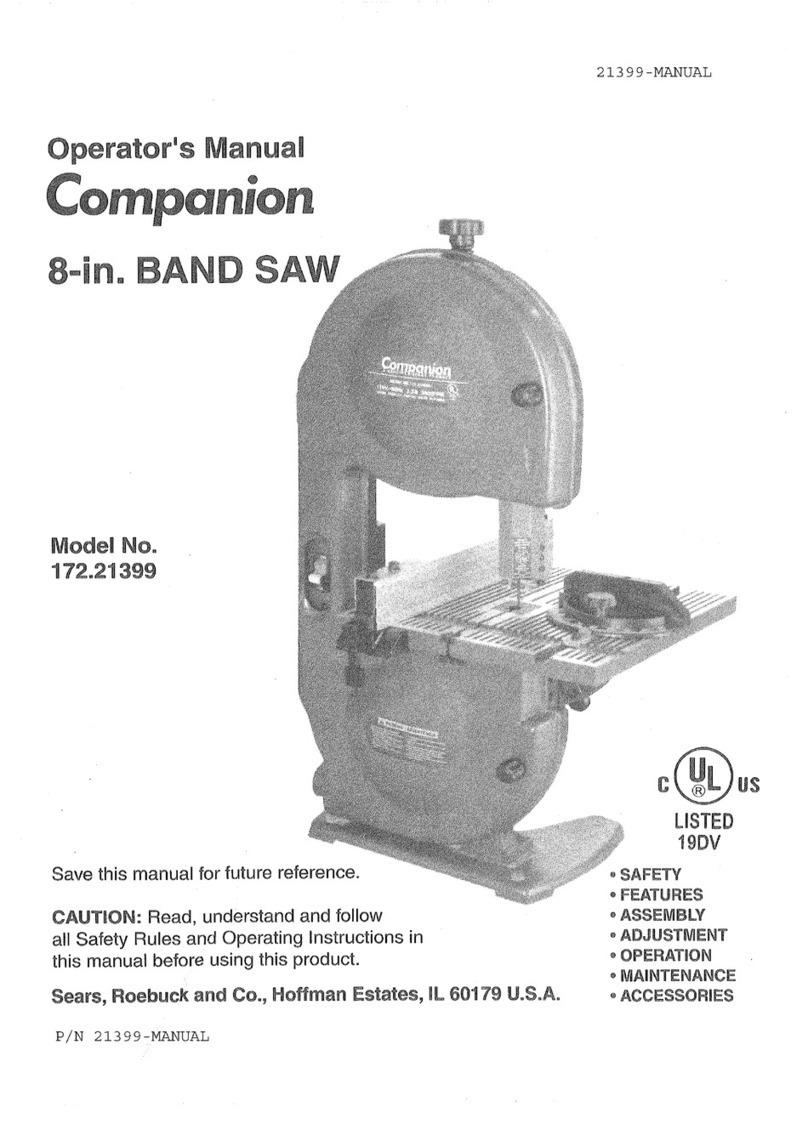
COMPANION
COMPANION 172.21399 Operator's manual
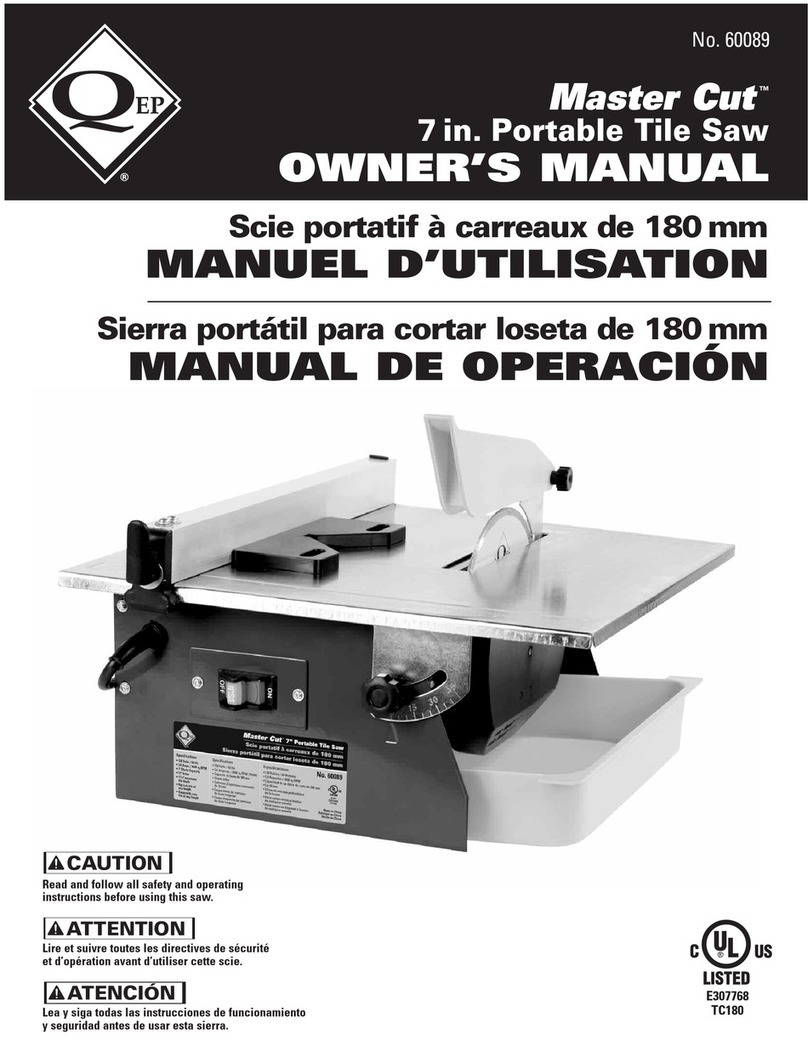
Master Cut
Master Cut 60089 owner's manual
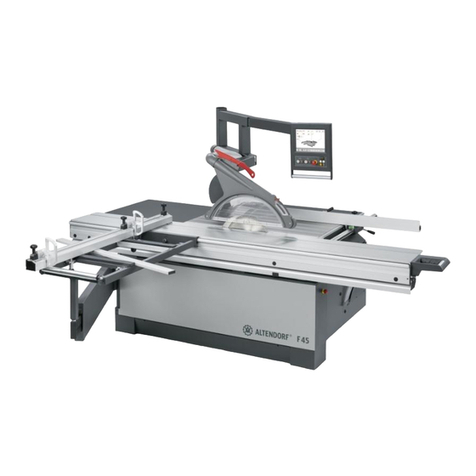
Altendorf
Altendorf ElmoDrive F45 operating manual
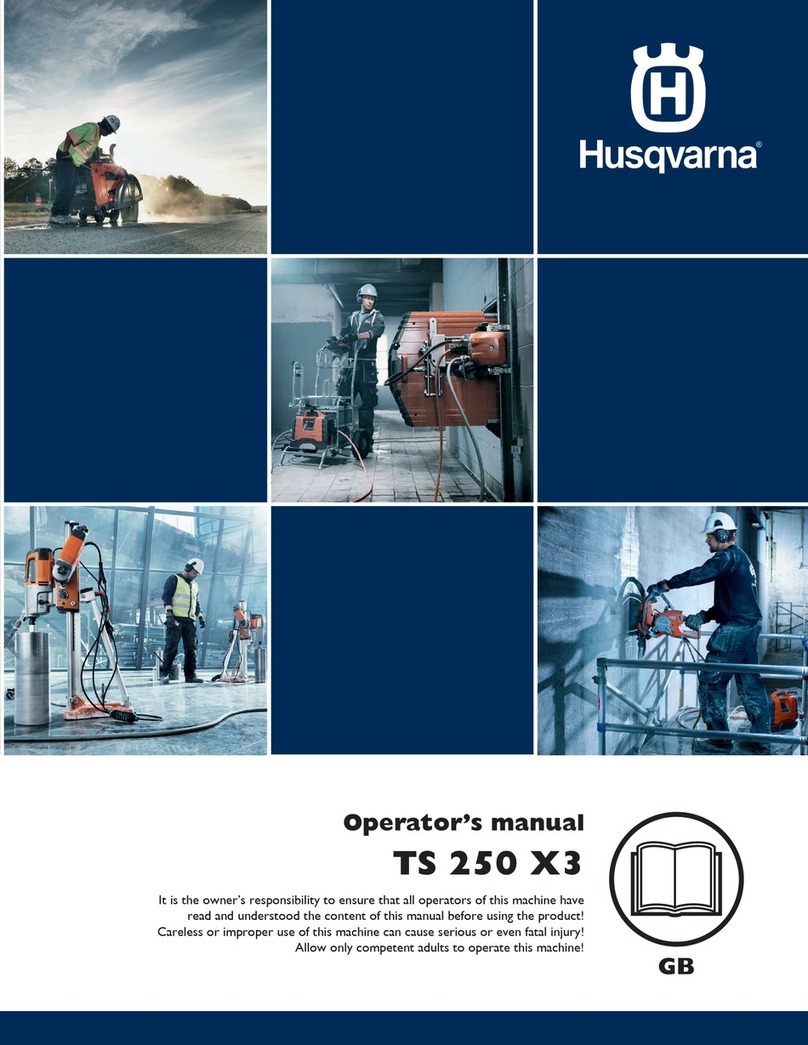
Husqvarna
Husqvarna TS 250 X3 Operator's manual

DeWalt
DeWalt D23551 Original instructions
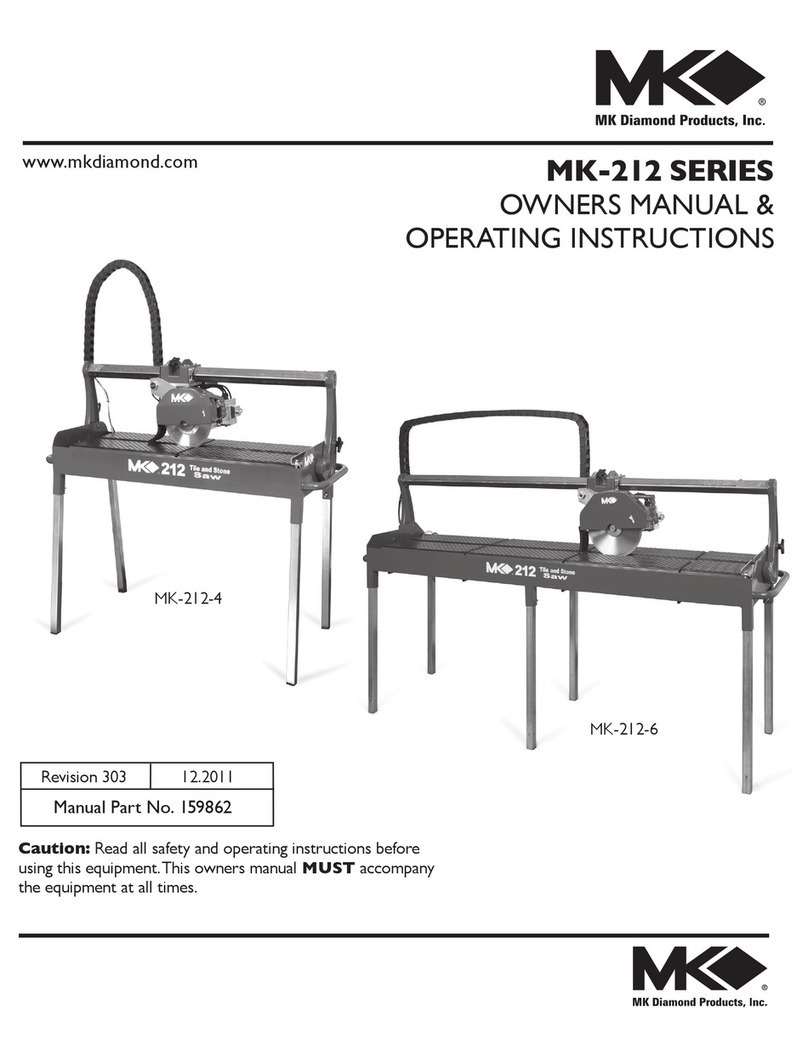
MK Diamond Products
MK Diamond Products MK-212 Series Owner's manual & operating instructions

